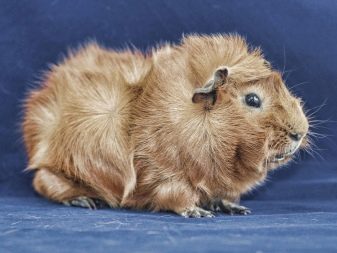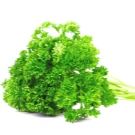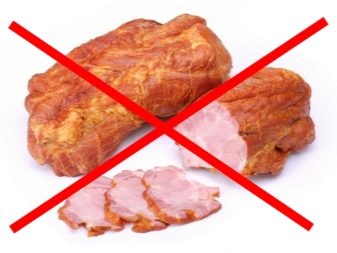Rosette guinea pigs: breed features and subtleties of care

The guinea pig is a friendly and affectionate pet that can be found in many people. One of the most unpretentious breeds is the Abyssinian pig, it is also called a rosette. This cute rodent will suit even a child as a friend. But in order for the animal to feel happy at home, it is necessary to provide it with comfortable conditions of detention.

Features of the breed
Choosing a wire-haired Abyssinian among guinea pigs, it is worthwhile to get acquainted with the features of this breed in advance. Rosette pigs have a good-natured character, they quickly tame and adapt to new conditions. Among individuals, there are rarely those who allow themselves to bite the owner's finger. Most often, animals are born black-white-red. Tortoiseshell and roan individuals are occasionally found.
The rosette pigs got their name for the presence of unusual patterns made of wool, similar to rosettes. Purebred animals have 8 to 12 symmetrically spaced outlets. Two sockets are located on the dorsum of the nose, in the forearm, on the hind legs, on the sacrum. Four more sockets can be on the back. Also, the breed can be distinguished by its pronounced mustache, protruding eyes, thick coarse hair, the presence of sideburns, wide-set ears.


Keeping an Abyssinian guinea pig in the house is often the only way out for asthmatics and allergy sufferers. There is rarely an allergy to the wool of these animals. In addition, these animals themselves have a fairly strong immunity to diseases, although sometimes it happens that ailments do not bypass them. It is believed that individuals of this breed are very smart and quick-witted and therefore easy to train.
Another important feature of outlets is their keen hearing. For example, a rodent can hear the approach of the owner, who has just entered the entrance, and begin to squeak happily, welcoming the owner.
Abyssinian pigs love to sit in human hands and get along well with children. Some pets can even lick the owner's fingers, thereby expressing their trust. However, when keeping it, it is important to take into account that pigs of this breed are afraid of sudden sounds and movements, any sudden change can lead to a panic attack.


In nature, guinea pigs prefer to live in groups of 5-10 individuals, they build burrows together and get food, and at home, two relatives often cannot get along, especially if they are of the same sex, and even more so if they are two males. Therefore, it is recommended to purchase only one pet, unless the owner plans to breed guinea pigs. Only littermates can get along well.
In the case of guinea pig breeding, you should prepare for the fact that the cubs may appear smooth-haired. This happens, and this situation is not considered a deviation from the norm. But if the babies have the wrong sockets or there are fewer of them than necessary, then, probably, the little pigs became the fruit of the love of non-purebred parents, and it is not recommended to breed these individuals further.
It is very important not to cross Abyssinian with long-haired breeds, since the resulting offspring is distinguished by chaotically located rosettes and does not carry any breeding value.


Conditions of detention
The life expectancy of a guinea pig at home is 8-10 years, but there are real long-livers who, with proper care, live up to 16 years. In order for the animal to live as long as possible, it is important to follow some recommendations for keeping. First of all, before buying a pet, the owner must buy a spacious cage, two walls of which are at least a meter long. Further, the future home should be equipped with various attributes:
- a house where the pig will rest, hide and store its supplies;
- feeder and drinker;
- toys for the release of energy of an active animal: a wheel, stairs, horizontal bars, labyrinths;
- hay nursery;
- mineral stone - needed for the health of the pet's teeth.


Sawdust or pellets are suitable as fillers. Judging by the reviews of the owners, wood pellets absorb rodent waste better, which means that they better protect against unpleasant odors.
It is recommended to arrange the toilet in the corner opposite to the trough.... The cage is cleaned once a week, and the feeders and drinkers need to be washed every day. Regular cleaning of the cage is an important procedure, as Abyssinians are quite clean animals.


Do not forget to purchase a hairbrush and brush, which you need to tidy up the rodent's fur once a week.
Rosette pigs tolerate cold enough, and in regions with a mild climate, they can be kept even outdoors. However, it is important to protect the animal from dampness and drafts. But the heat for these creatures can even be destructive, therefore never place the cage in direct sunlight.

Care
Observe the following guidelines when caring for a rosette pig.
- Try to take your pet out for a walk once a day.... To maintain health and increase life expectancy, it is important for him to move a lot. Before the pig goes for a walk around the apartment, do not forget to isolate other pets, and also warn the household to look under their feet. Block in advance all the places where the pig could climb and not get out. You can purchase a special walking ball at the pet store that will not allow the animal to escape or become prey for a domestic cat.
- Check the purity of the water carefully. Change the water daily, rinsing the drinker well. If you see debris in the container, change the water.The rodent needs at least 250 ml of liquid every day.
- Wipe your pet's fur with a damp cloth once a week to remove dead hair. Comb the rodent with a special comb. Choose a brush made of soft plastic material - such a product will not damage the skin of a fragile pet.
- Eat tree twigs to grind your teeth regularly. If the incisors grow back, they will damage the pet's cheeks, as a result of which the animal will always experience discomfort. In the wild, the rodent grinds off its claws during a constant run. When kept at home, his motor activity is somewhat limited, and therefore the claws grow rather quickly and give the animal inconvenience. Therefore, trim your nails regularly. If you are afraid to do it yourself, then take your pet to the veterinarian.
- The animal does not need bathing, this procedure can provoke stress. But if, nevertheless, there is a need to wash the pet with severe pollution, then the procedure is carried out in a basin with a non-slip bottom. The water temperature is moderate. Do not wash your pig in the area above the neck so that water does not enter the ears and eyes.


Particular attention should be paid to the nutrition of the Abyssinian guinea pig. The fact is that for the full development of these animals, vitamin C is needed, but their body does not produce it, so it is important to fill this gap with appropriate products. This element is found in rose hips, currants, parsley, bell pepper. Proper feeding of a rodent consists of the following ingredients:
- cereals (1 tbsp. l. per day): wheat, barley, rye;
- greens (bunch per day): dandelion leaves, clover, parsley;
- hay without limits;
- root vegetables: beets, carrots;
- fruits and berries: grapes, watermelons, mountain ash;
- vegetables: cabbage, peas, pumpkin, zucchini;
- special additives: vitamins and minerals.






Each pet has individual taste preferences. Seeing that the animal eats from what was offered in the first place, you can understand its taste preferences, and next time feed it with what it loves. It is also important to know what should not be offered to guinea pigs:
- meat, fish, any smoked products;
- confectionery, baked goods;
- canned food, canned or boiled vegetables;
- poorly washed or rotten roots.
Beware of giving pieces of food with mold, remove juicy vegetables from the feeder that the rodent has not eaten to protect the cage from the spread of mold.


Diseases
It was already noted above that rosette guinea pigs are famous for their strong immunity, but under poor conditions of detention, this immunity decreases, and then the animal runs the risk of becoming a victim of any disease. The most common ailments for these animals are parasites, diseases of the gastrointestinal tract, eye diseases, and ear mites. To prevent the development of the disease, observe the pet's behavior carefully. If you feel unwell, the rodent will hide deeper into the house and will not go out to greet the owner, he will not play and eat.

Any deviations in behavior should alert the owner.
It is also important to observe the external condition of the pet. So, periodically check the cleanliness of your guinea pig's ears. If a yellowish coating is found, it can be assumed that the pet has picked up an ear mite. Usually, this disease is indicated by the desire of the mumps to itch all the time. If you detect any symptoms of malaise in a pet rodent, immediately take the pet to the veterinarian.
In conclusion, we suggest you watch a video about adorable rosette guinea pigs.








